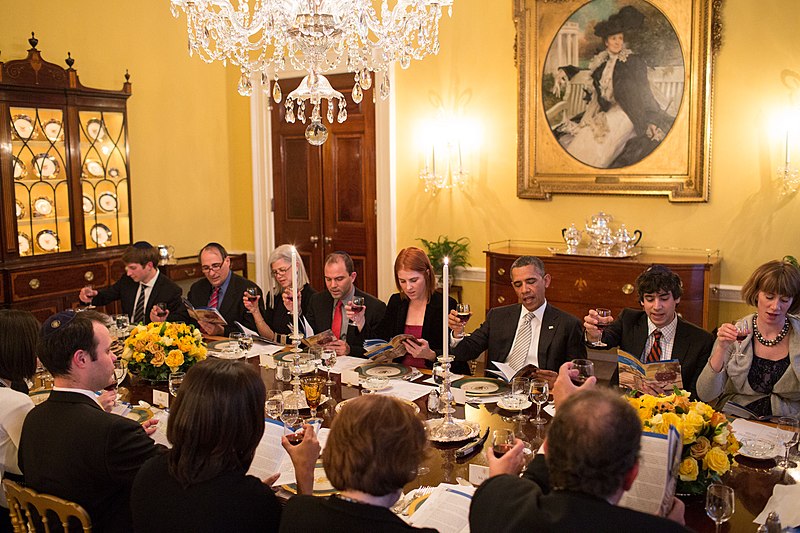It is in the midst of a rough presidential primary season. Three Reform Jewish staffers, on the campaign trail in Pennsylvania for their candidate, realize that they will not be able to make it home in time for Passover. So, they planned to scramble together a Seder that night. The candidate was interested in joining them. “I figured he was being polite,” one of the Jewish staffers, Eric Lesser, later reflected in the Daily Hampshire Gazette.
Just as they were about to begin the Seder in a windowless conference room in the basement of the hotel they were staying at, the presidential candidate pops in: “hey, is this the Seder?” He and some other staffers ended up joining them that night. Lesser noted in an interview with the Huffington Post that the candidate had been to many Seders, “so when we sat down he was very fluent in the story…and we actually went through the entire Haggadah.” At the conclusion of the Seder, everyone recited the usual “next year in Jerusalem.” The candidate added: “next year in the White House.”
So, who is this candidate that seemed to have such an affinity for one of the most popular Jewish traditions, the Seder? President Barack Obama. It was 2008 at a difficult point of his candidacy. The Pennsylvania primary was a few days away, and Obama’s association with controversial Reverend Jeremiah Wright was being highlighted in the news. “It was almost remarkable that everyone had the energy to get together and do [the Seder],” Herbie Ziskend, another of the three Jewish staffers, said in the Huffington Post interview.
As we all know, next year they indeed found themselves in the White House. “Hey,” Obama asked Lesser, “we’re doing the Seder again, right?” And so began what was a yearly tradition in the Obama administration — the White House Seder. It was the first time a president held and participated in a Seder in the White House.
The annual White House Seder was no public relations spectacle. Around twenty people from various backgrounds participated each year, including the first family. They used Maxwell House Haggadahs, and according to the Forward Obama would impersonate Pharaoh. In the Gazette, Lesser noted that Sasha Obama recited Ma Nishtana and she and her sister Malia would search for the afikomen.

Sara Netanyahu gave the Obama family a silver Seder plate. Dishware from the Truman administration was used as well, honoring the president who recognized Israel as it gained independence.
In one funny story from the first White House Seder, which the New York Times describes in a 2010 article as the “Macaroon Security Standoff,” Michelle Obama’s adviser’s husband had brought macaroons. “They were kosher for Passover, but not kosher with the Secret Service,” the Times quipped.
Obama tried to help, walking to the North Portico of the White House. He “peered out the door, startling tourists” who were probably also delighted to randomly see the president. His advisers convinced him to not go down to the gates, “fearing that would cause a ruckus.” Eventually Obama sent his personal aide Reggie Love to diffuse the situation.
In a 2016 statement marking the final Passover with them in the White House, Obama said that the White House Seder was “a tradition we have looked forward to each year.” Speaking in Israel in 2013, he said that he “brought this tradition into the White House…because I wanted my daughters to experience the Haggadah, and the story at the center of Passover that makes this time of year so powerful.”
Although Obama isn’t Jewish, he felt that a lot could be appreciated from the Passover story: “it’s a story about finding freedom in your own land. And for the Jewish people, this story is central to who you’ve become. But it’s also a story that holds within it the universal human experience, with all of its suffering, but also all of its salvation.”
Obama also tied the story of slavery in Egypt to the African-American experience. “Each year” at the Seder, Lesser recalls in the Gazette, “the President explained to his daughters and guests the centrality of the Exodus story to both Jewish and African-American spiritual traditions.”
The Obamas added something new to the Seder as well — everybody would read the Emancipation Proclamation, which declared that enslaved Americans must be freed. This speaks to a similar history that Jews and African-Americans share, of being freed from slavery. In the aforementioned speech Obama said that “to African-Americans, the story of the Exodus was perhaps the central story, the most powerful image about emerging from the grip of bondage to reach for liberty and human dignity.”
As we celebrate Pesach this year, it is worth recognizing how the story of the Jewish people’s freedom from oppression and slavery in Egypt, which is a core aspect of this holiday, speaks to and inspires many, even outside the religion, which is what President Obama emphasized when hosting the White House Seder.